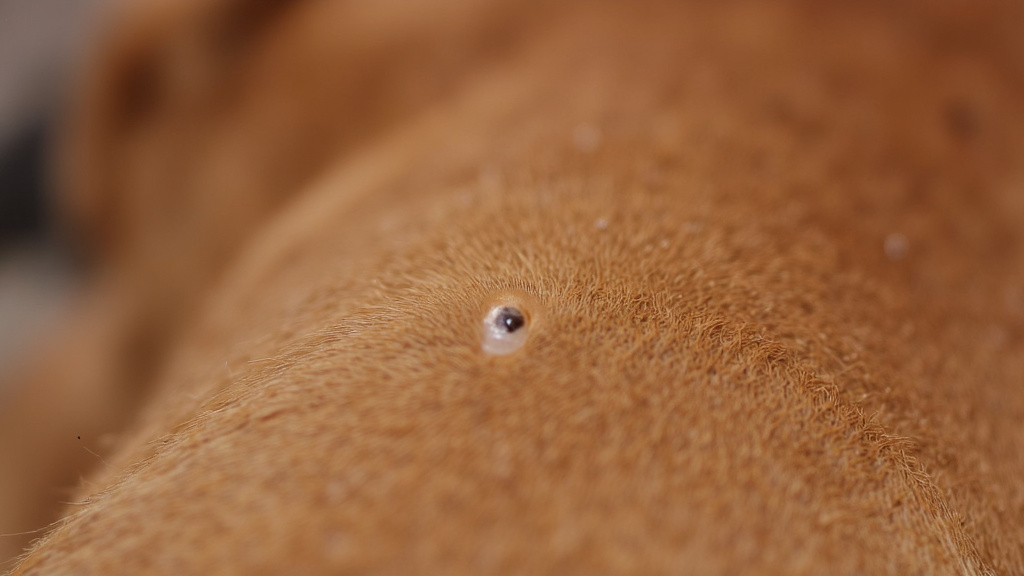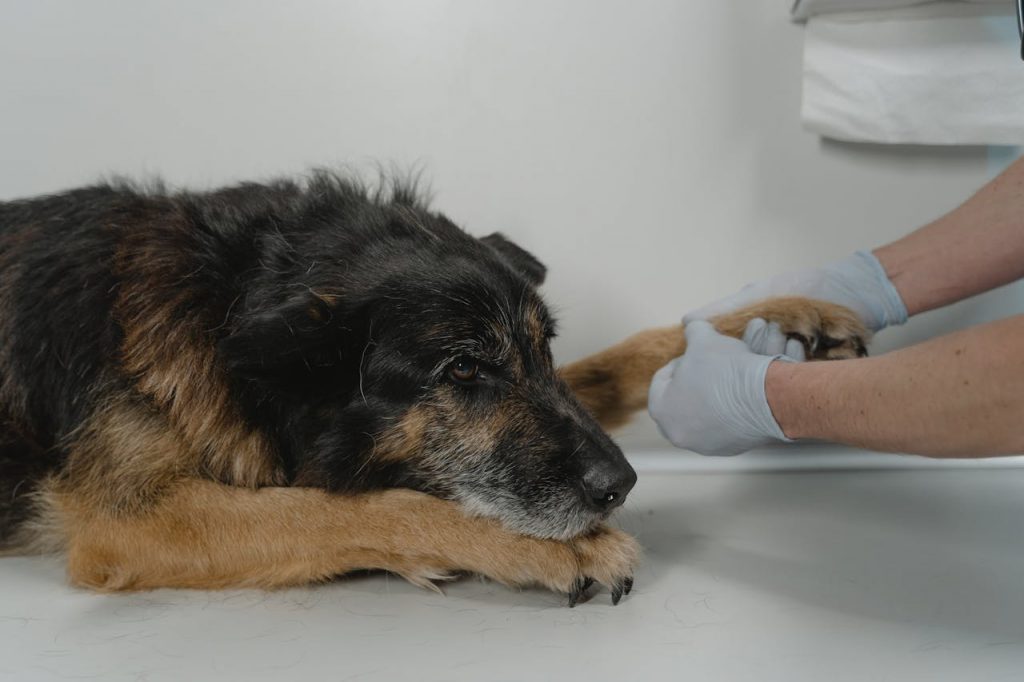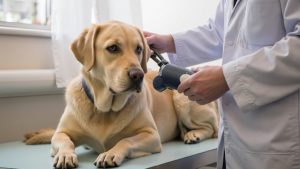
Finding an unexpected growth while petting your dog can be concerning. While discovering a new lump or bump often leads to late-night worrying, skin tags typically aren’t cause for alarm.
Dog skin tags are small, soft, fleshy growths that appear on the skin surface. These benign masses usually match your dog’s skin color or appear slightly darker, hanging from the skin like a tiny pendant on a narrow stalk. They range from barely noticeable bumps to larger flaps that may catch on objects. Skin tags have a distinctive soft, movable quality when touched.
These fibrovascular papillomas, as veterinarians call them, become more common as dogs age. Like humans, senior dogs tend to develop more of these harmless soft tissue masses over time. While they may appear concerning, skin tags are generally just a cosmetic issue rather than a health threat. Understanding when these growths warrant veterinary attention – and when they can simply be monitored during regular grooming – is key to proper care.
What Do Dog Skin Tags Look Like and Where Do They Appear?
Dog skin tags are distinct growths that vary in appearance. These soft, fleshy protrusions range from tiny specks to several centimeters across. They typically dangle from a slender stalk of tissue (known medically as pedunculated growths), distinguishing them from other skin conditions.
Unlike warts with their rough, cauliflower-like surface, skin tags have a smooth, uniform texture. They usually match your dog’s skin tone or appear slightly darker, making them challenging to spot on dogs with darker fur. Many owners discover them while grooming or petting their dogs.
Common Locations for Skin Tags
Skin tags typically develop in areas where skin experiences frequent friction. These benign growths have specific areas where they commonly appear:
The neck region is a primary location, particularly where collars create consistent contact. Other common sites include the loose skin folds in the armpits, groin, and chest where skin regularly touches during movement. Eyelids can also develop skin tags, requiring careful monitoring to prevent vision interference.
While less common, skin tags can appear anywhere on a dog’s body, including the face, trunk, and legs. Breeds with pronounced skin folds, such as Bulldogs or Shar-Peis, often develop these growths in their wrinkles where moisture and friction create favorable conditions for skin fold dermatitis and related issues.
A skin tag’s location can indicate its cause and potential complications. Tags in areas of constant friction—from collars, harnesses, or furniture—may become irritated. Regular health checks should focus on these areas, as the distinction between a harmless skin tag and a concerning growth often lies in changes to its appearance, texture, or your dog’s reaction to it.
For senior dogs, regular examination of these areas is crucial for early detection. Pay special attention to the chest, belly, and areas covered by thick fur, where tags can grow substantially before discovery.
| Location | Characteristic |
|---|---|
| Neck | Common due to collar friction |
| Armpit | Prone to skin rubbing |
| Groin and Chest | Frequently touched areas |
| Eyelids | Requires careful monitoring |
What Causes Skin Tags on Dogs?

Small, fleshy growths on your dog’s skin have several potential triggers. Age is the most common factor. Senior dogs develop skin tags more frequently as their skin loses elasticity and cell growth regulation changes. During veterinary consultations, eight-year-old Labradors typically show more skin tags than two-year-olds.
Genetics plays a crucial role. Certain breeds have a higher predisposition toward developing these benign growths. Boxers lead the pack, with Cocker Spaniels, Labrador Retrievers, and Doberman Pinschers following closely behind. Their genetic makeup contains coding that makes their skin cells more likely to form these growths over time.
Environmental Triggers
Daily activities contribute to skin tag development. Collars create persistent friction against the neck and chest areas. This repeated irritation can stimulate abnormal skin cell growth, especially in areas where skin naturally folds or rubs together. Regular checks under collars and harnesses during grooming sessions are recommended.
Sun exposure is another environmental factor. Dogs with shorter coats or those spending substantial time outdoors face increased UV radiation exposure. This damages skin cells over time, potentially triggering irregular growth patterns including skin tags. Continuous skin irritation from allergens or parasites creates similar effects through ongoing inflammation.
The Hormonal Connection
Hormones govern countless bodily functions, including skin cell growth and regulation. When these chemical messengers fall out of balance, skin tags often follow. Hypothyroidism stands out as a particular concern. Dogs with underactive thyroid glands frequently develop multiple skin tags alongside other symptoms. Adrenal gland imbalances create similar effects by disrupting normal cell turnover rates.
Weight matters too. Obesity creates additional skin folds and increases friction between skin surfaces. These conditions form perfect environments for skin tag development. The excess fat tissue also produces hormones that can disrupt normal skin cell behavior.
While genetics provides the foundation, these environmental and physical factors build upon that base. Understanding these causes allows for better prevention and monitoring strategies to maintain your dog’s skin health as they age.
When Should You Be Concerned About Your Dog’s Skin Tags?
Most skin tags on dogs are harmless, but recognizing when a growth becomes concerning can prevent pain and potential health issues.
Dogs develop skin tags due to age, genetics, and friction in areas like armpits or collars. While generally benign, certain changes require attention.
Warning Signs That Require Veterinary Attention
Rapid growth is a primary red flag. Benign skin tags develop gradually over months. A sudden size increase within days might indicate an aggressive growth. Veterinary specialists note that malignant tumors can double in size within weeks, unlike typical skin tags.
Color changes in skin tags need attention. Redness indicates inflammation, while purple or black coloring could suggest blood flow problems or malignancy. Dr. Mariella Roberts, a veterinary dermatologist, notes that malignant melanomas often appear as darkened, irregular growths resembling common skin tags.
Bleeding or discharge from a skin tag requires immediate veterinary evaluation. Healthy skin tags don’t bleed spontaneously or produce fluid. These symptoms suggest tissue damage, infection, or potential cancer.
Growth patterns and timing are significant indicators. While multiple skin tags commonly develop with age, sudden eruption of several growths could indicate immune system or health issues requiring evaluation.
Behavioral Indicators of Problems
Your dog’s reaction to a skin tag offers important insights. Pain when touched or persistent licking and scratching suggests abnormal discomfort.
Location affects concern levels. Skin tags near eyes, in the mouth, or on genitals need special attention as they can interfere with normal functions. Tags on eyelids may scratch the cornea, while oral tags can impact eating.
When Location Matters
Large breed dogs like Labrador Retrievers and Boxers are more prone to skin tags and certain skin cancers. Senior dogs develop more benign growths but face higher cancer risks, making veterinary assessment crucial for older large breeds.
Since 2020, veterinary dermatology has improved in distinguishing benign from malignant growths, but professional evaluation remains essential. A Journal of Small Animal Practice study found visual assessment alone accurately identified only 70% of skin cancers, emphasizing the importance of biopsy for suspicious growths.
| Warning Sign | Description |
|---|---|
| Rapid Growth | Sudden increase in size, indicating a more aggressive growth. |
| Color Changes | Red, purple, or black discoloration may indicate inflammation or malignancy. |
| Bleeding or Discharge | Spontaneous bleeding or fluid suggests damage or infection. |
| Pain or Discomfort | Persistent licking or scratching indicates the tag is causing discomfort. |
| Problematic Location | Tags near eyes or mouth may interfere with normal functions. |
How Are Dog Skin Tags Diagnosed and Treated?

When you notice unusual growths on your dog’s skin, getting a proper diagnosis is crucial before treatment begins. Veterinarians use several diagnostic approaches to confirm whether a growth is a skin tag or something more serious.
Veterinary Diagnostic Process
Most skin tags are diagnosed through visual examination. Your veterinarian will inspect the growth, noting its appearance, location, texture, and attachment to the skin. This initial assessment often provides enough information to identify a typical skin tag.
For unusual or concerning growths, your vet might recommend additional testing:
- Fine needle aspiration – a quick procedure where a small sample of cells is drawn from the growth using a thin needle
- Biopsy – removing a tiny tissue sample for microscopic examination
- Full medical history review – to identify potential factors contributing to skin tag development
These diagnostic steps help rule out more serious conditions like mast cell tumors or melanomas that can resemble benign skin tags. Professional diagnosis is essential as seemingly simple skin tags may require immediate attention.
Treatment Options for Dog Skin Tags
Many skin tags don’t require treatment if they aren’t causing problems. If your dog isn’t bothered by the tag and it isn’t growing or changing, your vet might recommend monitoring it. However, removal becomes necessary when tags are located in areas where they’re regularly irritated (like collar regions), bleeding frequently, growing rapidly, or causing discomfort.
Common Removal Procedures
Veterinarians typically use these techniques for skin tag removal:
Surgical Excision
The most common approach involves surgically removing the skin tag with a scalpel or scissors. The procedure is quick and precise, allowing removed tissue to be analyzed to confirm it’s benign. This method works well for larger skin tags or those with a broad base.
Cryotherapy
This technique uses extreme cold (typically liquid nitrogen) to freeze the skin tag, causing the tissue to die and fall off. It’s less invasive than surgery but may require multiple applications for complete removal, usually reserved for smaller skin tags with narrow stalks.
Cauterization
Using heat to burn off the skin tag, cauterization removes the growth and seals blood vessels to prevent bleeding. This method requires precision to avoid damaging surrounding healthy tissue.
Most procedures can be performed under local anesthesia during a regular appointment, though more extensive removals might require sedation.
Post-Removal Care
Proper aftercare prevents complications after skin tag removal. Your veterinarian will provide specific instructions, including:
- Keeping the area clean and dry
- Preventing your dog from licking, scratching, or rubbing the site (which might require an E-collar)
- Monitoring for signs of infection like redness, swelling, or discharge
- Applying any prescribed topical medications as directed
Most dogs recover within 7-14 days, depending on the removal method and treated area size. While home remedies might be tempting, professional veterinary care ensures your dog’s safety and comfort throughout the process.
Key Takeaways for Managing and Preventing Dog Skin Tags
Most skin tags on dogs are harmless, but monitoring their skin health is essential. Watch for new growths, rapid changes, or color shifts to address potential issues early. Regular grooming, hands-on inspections, proper nutrition, and weight management create a strong foundation for prevention.
Skin protection also depends on daily equipment choices. Well-fitted collars and harnesses help reduce friction that can lead to skin tags. The Halo Collar’s adjustable fit minimizes neck irritation while offering GPS tracking features. This design supports both outdoor safety and skin health by reducing friction in a common problem area.
For more information about canine skin care and health solutions, visit our Dog Health page for expert guidance and practical tips.





